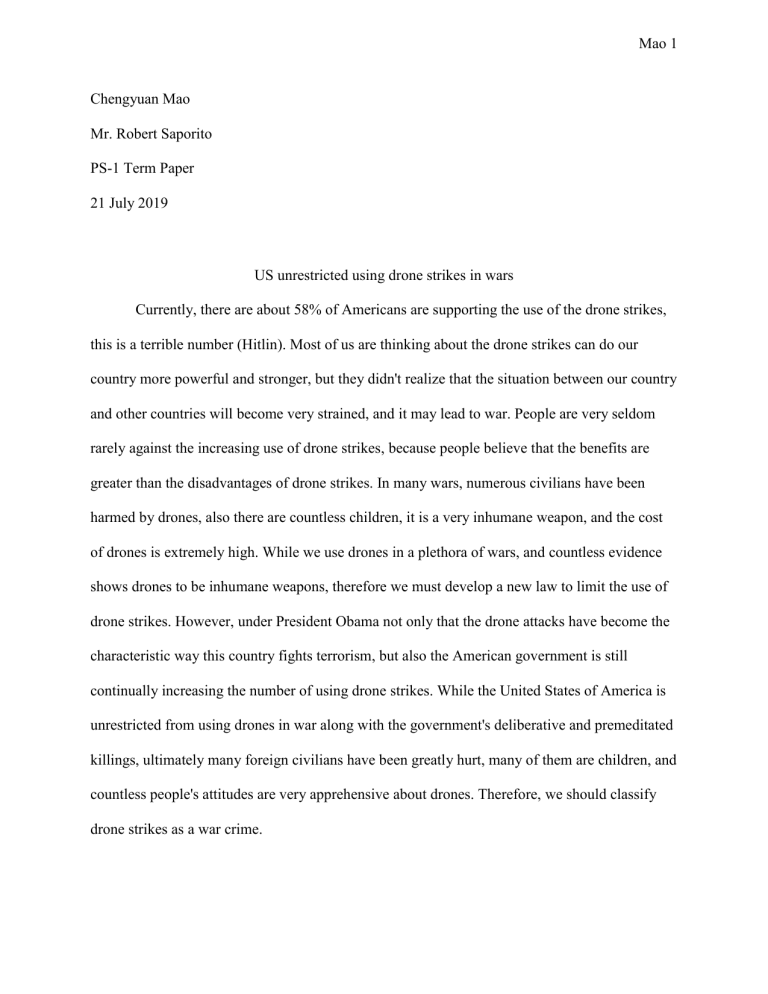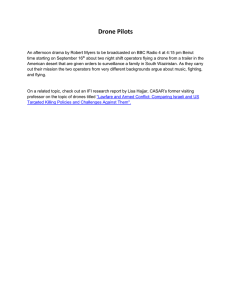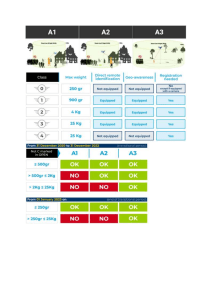
Mao 1 Chengyuan Mao Mr. Robert Saporito PS-1 Term Paper 21 July 2019 US unrestricted using drone strikes in wars Currently, there are about 58% of Americans are supporting the use of the drone strikes, this is a terrible number (Hitlin). Most of us are thinking about the drone strikes can do our country more powerful and stronger, but they didn't realize that the situation between our country and other countries will become very strained, and it may lead to war. People are very seldom rarely against the increasing use of drone strikes, because people believe that the benefits are greater than the disadvantages of drone strikes. In many wars, numerous civilians have been harmed by drones, also there are countless children, it is a very inhumane weapon, and the cost of drones is extremely high. While we use drones in a plethora of wars, and countless evidence shows drones to be inhumane weapons, therefore we must develop a new law to limit the use of drone strikes. However, under President Obama not only that the drone attacks have become the characteristic way this country fights terrorism, but also the American government is still continually increasing the number of using drone strikes. While the United States of America is unrestricted from using drones in war along with the government's deliberative and premeditated killings, ultimately many foreign civilians have been greatly hurt, many of them are children, and countless people's attitudes are very apprehensive about drones. Therefore, we should classify drone strikes as a war crime. Mao 2 It was seventeen years ago, on February 4, 2002, that the CIA first used an unmanned Predator drone in a targeted killing. The strike was in Paktia province in Afghanistan, near the city of Khost, if terrorists use them in an attack, casualties will be incalculable, and the drones have already caused many innocent people died. On the other hand, some people still believe that drones are very useful in wars, because drones can reduce casualties in wars, let drones replace humans in war, and they can accomplish very dangerous tasks. Actually, according to “The Increasing Use of Drone Strikes Demands International Regulation”, which reads “From September 2001 to April 2012, the U.S. military increased its drone inventory from fifty to seventy-five hundred—of which approximately 5 percent can be armed” (Zenko). This evidence shows that the American government was increasing the use of drone strikes in the military, that will indirectly cause more people died. While it may seem that the drone strikes can make more effectively to our military and a lot of benefits, as a matter of fact, it’s more likely that the drone strikes are causing more deaths, in many wars, numerous civilians have been harmed by drones, even though there is a plethora of children. The drone strikes kill more civilians than terrorists. In an article titled “The Dangerous Seduction of Drones,” from “Gale”, Medea Benjamin comments that the drone is a very inhumane weapon, who insists, “U.S. forces have hit Pakistan with more than 350 drones strikes since 2004. These U.S.-engineered operations have left a death toll of somewhere between 2,500 and 3,500 people, including almost 200 children” (Benjamin). Basically, Benjamin suggests that, if we didn't limit the use of drones, the number of casualties will be uncountable. Additionally, there are a lot of people are rage and panic of the drones, it already caused many people to die. According to an article titled “Drone Strikes Are an Ethical Response to Terrorism”, which reads “As the US withdrew from Iraq and first surged and then prepared to withdraw from Mao 3 Afghanistan, so the number of drone attacks, particularly in northwest Pakistan, increased. "Militant" bases and leaders ("terrorist" now being regarded as an unanalytical expression) have been pulverised in remote and perilous places without the loss of a single soldier or flier. And for remarkably little cost. Drones were the Heineken [a beer] of warfare” (Aaronovitch). Basically, Aaronovitch suggests that the drones caused fear and anger in Afghanistan, it is a killing weapon and increases the casualties in the war. This idea is important because, in many wars, there are numerous civilians who have been harmed by drones, also there are countless children. And so, we should restrict the use of drone strikes and classify it as a war crime. Not only that, but data from the most recent attacks show that they are not killing anyone which violates rule 50 of the Geneva Convention and therefore should classify as a war crime. In the most recent drone strikes attack, these drones did not harm anyone because of the strike, so it didn’t need to continue to be used in the military, and it also causes extensive destruction of property. According to an article titled “How Drones Changed the Game in Pakistan”, which reads “The majority focused on the psychological impact of the drones and how they have put militants on the run, forcing them to sleep under trees at night, though it must be said that army officials showed some concern about cases in which the same psychological impact is experienced by civilians” (Nadim). Basically, Nadim is saying that the attack of drones is a disaster for Pakistan. In many of the current wars, these strikes are not needed anymore as targets don’t pose a current threat to the U.S. Not only there are many of the enemy's equipment is far less equipped than the US military's wellequipped, but also the US military can easily attack them without the need for high technology like drones. In an article titled “Using Drones to Fight Terrorism Has Been Harmful and Ineffective,” Ramesh Thakur contends that the drone strikes are useless, who insists, “Yet there is no clear evidence that they have made America safer overall” (Thakur). Basically, Thakur said Mao 4 that some people think that drones are not helpful during the war and even cause more deaths, and there are increasingly people are standing up against the use of drones, it didn't help our society at all. This idea is important because if the drone is not used in the right way, it could also be a killing weapon. According to an article titled “The Dangerous Seduction of Drones”, which reads, “Despite being billed as a weapon of precision, only 2 percent of those killed in these drone strikes have been high-level Taliban or al-Qaeda operatives. Most have been either innocent people or low-level militants” (Benjamin). This text proves that drones can't effectively distinguish which enemies should be killed in the usual situation. In other words, according to this article, only about 2% of all killed enemies die is valuable to the United States, and the deaths of the remaining 98% people are not of great value. Moreover, there are many civilians and even children. The death of soldiers in war is normal because there must have people die in war, and the war always costs something, important or not, this is an undeniable fact, but war should not affect the lives of civilians and children, because they have no weapons, they are neither the initiator of the war or the participant of war, they should be excluded from the war. The excessive use of drones will reduce the death rate of US soldiers, but the use of drones will increase the death of foreign civilians, this is a very abnormal logic and fact. The US government is indifferent to the response to drones. They think that drones are good for the United States, so they have not responded effectively to the incident of drones harming civilians or created new laws to limit these inhumane weapons. According to the article titled “How Drones Are Used to Fight Terrorism Requires Public Debate”, it reads, “Few experts, including Krauthammer, think the drone strikes should be halted or that the U.S. should return to its pre-Sept. 11 complacency. In those days, neither the Clinton nor Bush administrations showed sufficient zeal for targeting Osama bin Laden, despite rock-solid CIA Mao 5 intelligence that he was targeting us” (Iannotta). There are seldom rarely people think we should limit the use of drones, however, there are more than half of Americans think the US should continually use drones in war against enemies just because drones can decrease the death of American soldiers, but the people who think we can still using drones, they completely ignore the death of the foreign civilians. According to an article titled “US Drone Strikes: Victims Legitimacy?” it reads, “For US political and military administrations, the repercussions in the aftermath of drone strikes never remained a national security priority. In fact, the Americans were familiar with the militants' capabilities to retaliate, which have implications only for Pakistan, not for the USA,” and “After all in their (the US) constitutional obligation only the lives of Americans matter, the rest of the world is just a meadow for their political gambling” (Sargana). Actually, this shows that not only the US government doesn't want to respond to the question which is regarded by the whole world, but also there are more than 60,000 civilians have had to give their lives, including law enforcement officials and children. According to an article titled “Drones, Drone Strikes, and US Policy: The Politics of Unmanned Aerial Vehicles”, which reads “...neither the United States nor the Pakistani government has made real efforts to fight misperceptions or even deliberate misrepresentations, which is why these misperceptions have spread” (Franke). That is indicated about the problem of drone strikes used to combat terrorists to harm civilians has not received much attention. Instead, many people question whether this decision of drone strikes really deserves its value and cost or not at all. The most crucial point is that the costs of the drone strikes are extremely expensive, If we reduce this weapon with great lethality and high cost, we can use it to create more citizen welfare or create something more valuable than the drone strikes. Not only that, but also if we decided to decrease the number of drones, the relationship between the United States and other countries Mao 6 can be alleviated, so that everyone can create more benefits. According to an article titled “Understanding Drones”, from “Friends Committee ON NATIONAL LEGISLATION” which reads, “Ten unarmed Predator drones, cost approximately $62 million a year” (Understanding Drones). That’s only 10 drones, not to mention the costs of the flight, which are, according to the same article, about “$2,500-$3,500”. This is true because drones always carry a lot of high-tech to complete more types and more dangerous tasks, so the cost of drones is very high. The drone will feature technology using composite materials, radar absorbing materials, and low noise engines and limited infrared reflection technology. The new drone will feature state-of-the-art stealth technology using composite materials, radar absorbing materials, and low noise engines and limited infrared reflection technology. In order to enhance the drone ‘s all-weather reconnaissance capability, the photoelectric infrared sensor is installed on the aircraft and the digital transmission method is diversified. Then in order to ensure timely and uninterrupted data transmission between the drone and the ground station, the advanced drone adopts a variety of digital transmission systems. Not only that, but also in order to ensure timely and uninterrupted data transmission between the drone and the ground station, the advanced drone adopts a variety of digital transmission systems. These technologies are very helpful in war, they are useful, but the cost of all these technologies on drones is very high, as a result, we need to spend a lot of manpower and resources to manufacture and repair these futile drones, then we cannot use this money to create a more social welfare. That is not enough. The drone is controlled by humans remotely, as a result, people can only use the camera on the drone to observe the surrounding conditions, and cannot make a direct response, which will increase the failure rate of the task, also it may injure civilians. Not only that the drone vulnerable to interference from other electronic devices, the drone maybe can't receive the signal or there is a delay in the instructions Mao 7 that people send to it, but also that the operating system of the drone may be invaded by the enemy, thus becoming the enemy's killing weapon, which is very precarious. The drone is a large-scale anti-personnel weapon, it is very inhuman, and the drone should be regarded as a war crime. But in the current war, we can still see countless drones cruelly killing many civilians, the drone strikes either kill too many civilians or nobody at all and are just a colossal waste of money, therefore, there is no need for these strikes. Drones should be restricted, but many people are unaware of the problem, and they think it should be legal to use drones. In today's society, the US government does not care about the drone's policies, and most people do not pay attention to this issue, they think that drones are not enough to have such big damage and impact, this is a very horrible fact. Although there are still many people who condemn drones as an inhumane weapon, there are too few people who insist on opposing drone policies. The power of these people is insignificant in this huge and incomparable society, also the US government believes that drones can bring a lot of benefits to the United States, so they continue to increase the use of drones in war, but they all ignore the fact that countless civilians and children are being harmed by drones abroad, killing machines versus the unarmed civilians, this is unfair and ridiculous. War policies should not involve civilians and children, as the US government is unrestrictedly using more drones in the war, more and more people are getting hurt, this is a very human weapon. The U.S. government’s policy on drones should take into account the need to protect civilians, which is what today’s society needs. Mao 8 Works Cited Aaronovitch, David. "Drone Strikes Are an Ethical Response to Terrorism." Afghanistan, edited by Noah Berlatsky, Farmington Hills, MI, Greenhaven Press, 2015. Opposing Viewpoints. Opposing Viewpoints in Context, link.galegroup.com/apps/doc/EJ3010446283/OVIC?u=etiwanda_hsl&sid=OVIC&xid=9b 94782b. Accessed 23 Jan. 2019. Originally published as "Would You Prefer Drones or Jihadis?" in Australian, 24 Nov. 2012. Benjamin, Medea. "The Dangerous Seduction of Drones." Drones, edited by Tamara Thompson, Farmington Hills, MI, Greenhaven Press, 2016. Current Controversies. Opposing Viewpoints in Context, link.galegroup.com/apps/doc/EJ3010977217/OVIC?u=etiwanda_hsl&sid=OVIC&xid=6d d04bd6. Accessed 23 Jan. 2019. Originally published in Otherwords.org, 12 Feb. 2014. Franke, Ulrike E. "Drones, Drone Strikes, and US Policy: The Politics of Unmanned Aerial Vehicles." Parameters, vol. 44, no. 1, 2014, pp. 121-130. ProQuest, https://search.proquest.com/docview/1532990053?accountid=153102. Hitlin, Paul, and Paul Hitlin. “How Americans Feel about Drones and Ways to Use Them.” Pew Research Center, Pew Research Center, 19 Dec. 2017, www.pewresearch.org/facttank/2017/12/19/8-of-americans-say-they-own-a-drone-while-more-than-half-have-seenone-in-operation/. Iannotta, Ben. "How Drones Are Used to Fight Terrorism Requires Public Debate." Drones, edited by Louise Gerdes, Detroit, MI, Greenhaven Press, 2014. At Issue. Opposing Viewpoints in Context, link.galegroup.com/apps/doc/EJ3010888210/OVIC?u=etiwanda_hsl&sid=OVIC&xid=89 Mao 9 24f8f4. Accessed 22 Jan. 2019. Originally published as "Editorial: Debate the Drone War" in Defense News, 28 June 2012. Nadim, Hussain. "How Drones Changed the Game in Pakistan." Drones, edited by Louise Gerdes, Detroit, MI, Greenhaven Press, 2014. At Issue. Opposing Viewpoints in Context, link.galegroup.com/apps/doc/EJ3010888205/OVIC?u=etiwanda_hsl&sid=OVIC&xid=55 d73a78. Accessed 23 Jan. 2019. Originally published in The National Interest, 3 Aug. 2012. Sargana, Tauqeer H. "US Drone Strikes: Victims Legitimacy?" Defence Journal, vol. 20, no. 5, 2016, pp. 13-18. ProQuest, https://search.proquest.com/docview/1861052636?accountid=153102. Spurlock, Matthew. "America's Foreign Drone Strike Program Lacks Transparency." Drones, edited by Tamara Thompson, Farmington Hills, MI, Greenhaven Press, 2016. Current Controversies. Opposing Viewpoints in Context, link.galegroup.com/apps/doc/EJ3010977216/OVIC?u=etiwanda_hsl&sid=OVIC&xid=fe 4fe3ce. Accessed 22 Jan. 2019. Originally published as "Obama Promised Transparency on Drones, but We're Still in the Dark" in Aclu.org, 16 Mar. 2015. Thakur, Ramesh. "Using Drones to Fight Terrorism Has Been Harmful and Ineffective." Drones, edited by Louise Gerdes, Detroit, MI, Greenhaven Press, 2014. At Issue. Opposing Viewpoints in Context, link.galegroup.com/apps/doc/EJ3010888203/OVIC?u=etiwanda_hsl&sid=OVIC&xid=a2 9fc04c. Accessed 18 Jan. 2019. Originally published as "Drones Harm More than Help" in Japan Times, 11 Oct. 2012. Zenko, Micah. "The Increasing Use of Drone Strikes Demands International Regulation." US Mao 10 Foreign Policy, edited by Noël Merino, Farmington Hills, MI, Greenhaven Press, 2015. Opposing Viewpoints. Opposing Viewpoints in Context, link.galegroup.com/apps/doc/EJ3010933210/OVIC?u=etiwanda_hsl&sid=OVIC&xid=833b6cce . Accessed 18 Jan. 2019. Originally published as "Reforming U.S. Drone Strike Policies" in Council Special Report, vol. 3, Jan. 2013.




